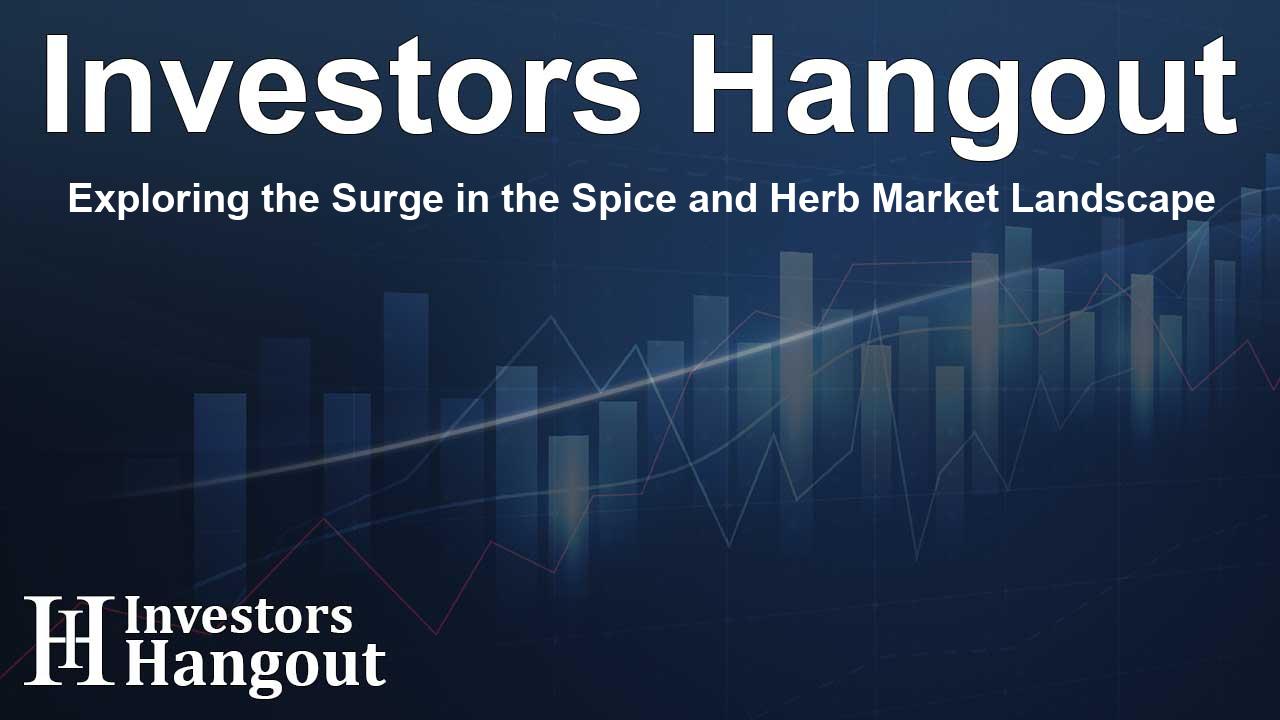Exploring the Surge in the Spice and Herb Market Landscape

Understanding the Growth of the Spice and Herb Market
The spice and herb market is experiencing remarkable expansion, with projections indicating that it could reach US$ 275.01 billion by 2034. A recent report reveals that this market is set to grow significantly, starting from a valuation of US$ 172.08 billion in 2024, and expanding at a compound annual growth rate (CAGR) of 4.8% during the upcoming decade.
Drivers of Growth in the Market
The increasing demand for spices and herbs stems largely from the food processing industry, which heavily incorporates these ingredients into various products, such as seasonings, sauces, ready-to-eat meals, and snacks. Manufacturers, aiming to meet consumer preferences for flavorful and convenient meals, are leveraging herbs and spices to enhance taste while promoting a natural ingredient philosophy. As competition intensifies, companies are continually launching innovative products to stay ahead in the market.
Regional Insights: North America Takes the Lead
In terms of market positioning, North America is expected to play a pivotal role throughout this growth period. A surge in demand for organic and functional spices has been observed, particularly for products recognized for their health benefits, including turmeric and ginger. As consumers become more health-conscious, these spices are gaining traction in North American households.
Key Market Takeaways
- The overall market for spices and herbs is projected to touch a staggering US$ 275.01 billion by 2034.
- Regions in East Asia are expected to reach a market size of approximately US$ 38.55 billion by 2024.
- China's contribution to the East Asia market share is anticipated to be around 9% by 2024.
- North America is likely to hold approximately 3% of the global market share by 2034.
- The trend for powder and granule forms of spices and herbs is projected to grow at a 3% CAGR from 2024 to 2034.
- Specifically, the demand for spices and herbs in South Korea is forecasted to be around US$ 14.67 billion by the end of 2034.
Innovation Among Leading Companies
Several key players are shaping the future of the spice and herb industry. Companies such as Koninklijke Euroma BV, DF World of Spices GmbH, and McCormick & Company, Inc. are leading the charge in innovation. They continuously strive to enhance their offerings to cater to a broader array of culinary applications and dietary preferences, including gluten-free and organic options. This evolution is necessary to meet the diverse needs of today’s consumers.
Shifts in Consumer Preferences
Modern consumers increasingly prefer spices and herbs in powder or granule form. This popularity is driven by convenience, as these forms are easily integrated into various recipes without extensive preparation. Moreover, powdered spices tend to have a longer shelf life, which appeals to many home cooks. This format not only brings robust flavors and aromas but also enhances the overall culinary experience.
Industry Developments and News
Several recent developments highlight the ongoing evolution within the spice and herb market. Freddie Hirsch Nigeria has recently introduced a new range of seasonings that celebrate the flavors of Africa, aiming to enrich various culinary traditions. Similarly, Grace Foods United Kingdom has launched a Jamaican Honey Jerk Seasoning that promises to deliver a unique blend of sweet and spicy flavors. Additionally, notable providers like Starwest Botanicals are responding to increasing consumer demand for natural ingredients by introducing innovative packaging solutions, such as the Eco-Pouch for herbs and spices.
Market Analysis and Insights
Research conducted by Fact.MR offers a thorough look into the spice and herb market, covering historical demand data from 2019 to 2023 and providing insights for the expected trends from 2024 to 2034. The analysis spans various segments, including spices like cardamom and turmeric, herbs such as oregano and basil, and different distribution channels across major global regions.
Frequently Asked Questions
What is the expected value of the spice and herb market by 2034?
The spice and herb market is projected to reach approximately US$ 275.01 billion by 2034.
Which region is leading in the spice and herb market?
North America is expected to hold a prominent position due to heightened demand for organic spices.
What factors are driving the demand for spices and herbs?
The increasing involvement of spices and herbs in the food processing industry and changing consumer preferences towards health-conscious choices are key drivers.
What types of products are popular in the spice and herb market?
Powdered and granule spices and herbs are particularly popular due to their convenience and ease of use.
Who are the key players in the spice and herb industry?
Key players include Koninklijke Euroma BV, McCormick & Company, Inc., and Everest Spices, among others.
About Investors Hangout
Investors Hangout is a leading online stock forum for financial discussion and learning, offering a wide range of free tools and resources. It draws in traders of all levels, who exchange market knowledge, investigate trading tactics, and keep an eye on industry developments in real time. Featuring financial articles, stock message boards, quotes, charts, company profiles, and live news updates. Through cooperative learning and a wealth of informational resources, it helps users from novices creating their first portfolios to experts honing their techniques. Join Investors Hangout today: https://investorshangout.com/
Disclaimer: The content of this article is solely for general informational purposes only; it does not represent legal, financial, or investment advice. Investors Hangout does not offer financial advice; the author is not a licensed financial advisor. Consult a qualified advisor before making any financial or investment decisions based on this article. The author's interpretation of publicly available data shapes the opinions presented here; as a result, they should not be taken as advice to purchase, sell, or hold any securities mentioned or any other investments. The author does not guarantee the accuracy, completeness, or timeliness of any material, providing it "as is." Information and market conditions may change; past performance is not indicative of future outcomes. If any of the material offered here is inaccurate, please contact us for corrections.